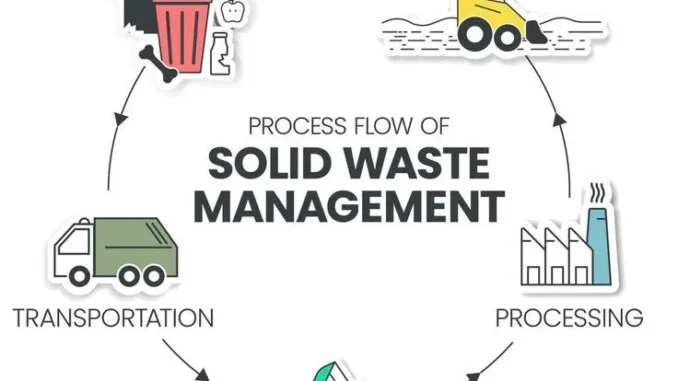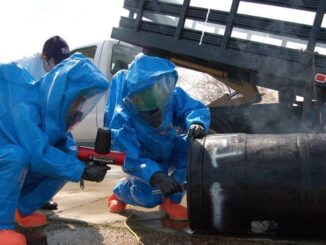
HAZWOPER: Hazardous Waste Operations and Emergency Response
Scope – What’s covered?
OSHA 1926.65a: HAZWOPER, Applies to worker activities involving hazardous substances, unless the employer proves no exposure risk:
- Mandatory clean-ups at uncontrolled waste sites (e.g., EPA NPL-listed sites).
- RCRA corrective actions at regulated hazardous waste facilities.
- Voluntary clean-ups at government-recognized hazardous sites.
- Work at TSD facilities (treatment, storage, disposal).
- Emergency responses to actual or threatened hazardous substance releases—location is irrelevant.
OSHA 1926.65a: HAZWOPER, Application – Which Rules Apply?
- OSHA rules in 1910 and 1926 still apply; always choose the strictest.
- Clean-up operations under (1)–(3) must follow this entire section, except paragraphs (p) and (q).
- TSD activities under (4) follow only paragraph (p).
- All other emergency responses (including incidental releases) must meet paragraph (q).
Key Definitions: OSHA 1926.65a HAZWOPER
- Partner system: Each monitors the other.
- Clean-up: Removal, stabilization, or containment of hazardous substances.
- De-contamination: Eliminate hazardous residue from people and environment.
- Facility/Site: Any location where hazardous substances are placed, stored, or released.
- HAZMAT team: Trained responders designated to manage hazards from substances.
OSHA 1926.65a: Key Terms (HAZWOPER Definitions)
- Hazardous Substance: Includes materials defined under CERCLA, DOT-regulated hazardous goods (49 CFR 172.101), biological/pathogenic agents, and hazardous wastes (40 CFR 261.3 or 49 CFR 171.8).
- Hazardous Waste Site: Any location, where hazardous operations occur.
- IDLH (Immediately Dangerous to Life or Health): Air concentration posing immediate threat or irreversible harm.
- Oxygen Deficiency: Atmosphere with under 19.5% oxygen, requiring respiratory protection.
- PELs & Published Exposure Levels: Permissible exposure limits (OSHA) or NIOSH/ACGIH exposure guidelines.
- Decontamination: Removal of contaminants from personnel and equipment to prevent harm.
- Emergency Response: Action in response to uncontrolled or potentially uncontrolled hazardous substance releases; minor spills are not covered.
- Buddy System: Pairing employees so each monitors the other.
- Qualified Person: Someone with training and authority to oversee specific tasks.
- Site Safety & Health Supervisor: The on-site individual responsible for implementing and enforcing the site’s safety plan.
- Small Quantity Generator: Produces ≤1,000 kg of hazardous waste in a month.
OSHA 1926.65b: Safety & Health Program Essentials
It must include:
- Organizational Structure – Defines roles, responsibilities, and chains of command.
- Comprehensive Work plan – Outlines tasks, required resources, training, and logistics.
- Site-Specific Safety & Health Plan – Addresses hazards, PPE, decontamination, emergency response, confined spaces, air monitoring, and spill control.
- Training Program – Covers all hazards, safe procedures, PPE, and emergency actions.
- Medical Surveillance – Monitoring worker health as needed.
- Standard Operating Procedures – Task-by-task safety guidelines.
- Coordination Mechanisms – Integration between general and site-specific protocols.
Additional Requirements
- Excavation Safety: Trenches and dig sites must be sloped or shored per OSHA’s construction standards.
- Contractor Coordination: Employers must share safety plans and emergency procedures with all contractors and subcontractors on-site.
- Accessibility: The written program must be readily available to employees, representatives, contractors, OSHA, and regulatory agencies.
Organizational Structure: 1926.65b2
Your site safety program must clearly define who does what and who reports to whom, including:
- A General Supervisor with overall authority for hazardous waste operations
- A Site Safety & Health Supervisor responsible for developing and enforcing the on-site safety plan
- All other key personnel listed with their roles and responsibilities
- Clear lines of authority, communications, and supervision
This structure should be regularly reviewed and updated to reflect changes at the worksite.
Comprehensive Work plan: 1926.65b3
Your written work plan must detail:
- Tasks and objectives (including planned clean-ups and routine work)
- Methods and resources
- Personnel requirements — who does what
- How training, information provision, and medical surveillance will be managed on-site
This ensures all operations are well-defined and supported by logistics, staffing, and health programs.
Site-Specific Safety & Health Plan: 1926.65b4
The on-site safety plan (HASP) must cover each phase of the job and include:
- Hazard analysis for every task
- Training assignments linked to identified risks
- PPE requirements for different site activities
- Medical checkup, and environmental sampling
- Site control measures, decontamination procedures, emergency response strategies, confined-space protocols, and spill containment
- Pre-entry session, when work starts/situations change
- Inspections by the site safety supervisor to ensure plan effectiveness, with any issues promptly corrected and updated on-site
Essential Pre-Entry Site Information: 1926.65c4
Before sending workers in, the employer must gather:
- Site location, size, terrain, and access routes
- Task details and expected duration
- Known hazards, potential exposure pathways, and chemical properties
- Emergency team readiness and response resources on site
PPE Recommendations for Initial Entry: 1926.65c5
- Choose PPE based on pre-site evaluation to keep exposures below legal limits.
- If respiratory risks exist and no positive-pressure SCBA is used, carry a 5‑minute escape unit.
- When hazards are undefined, start with at least Level B gear and use instruments to check for IDLH conditions.
- Refine PPE choices once site hazards are fully understood.
Monitoring During Entry: 1926.65c6
- Use real-time detectors for radiation, oxygen levels, toxic gases, and IDLH threats.
- Visually monitor for any dangerous buildup or atmosphere.
- After proving the site is safe, continue periodic air quality checks throughout operations.
Risk Communication & Training: 1926.65c7.8
- Identify and inform workers about all known or potential risks, including inhalation, absorption, flammability, radiation, oxygen deficiency, and more.
- Share chemical safety data (SDS) and any other relevant info before work starts.
Site Control Requirements: 1926.65d
- Develop and implement a site control program before operations begin.
- Plan must include:
- A map, site zones, and a buddy system
- Communication and emergency alert systems
- Standard safe-work procedures
- Location of medical aid
OSHA 1926.65e: HAZWOPER Training Requirements
1. Who Needs It?
- Any worker exposed to hazardous substances or safety risks, plus supervisors and managers overseeing site operations must be trained before starting work and receive regular refreshers
2. What Must Training Cover?
- Site roles and alternates
- Hazards present
- Proper PPE use
- Safe work practices
- Use of control equipment
- Medical monitoring and symptom recognition
- Elements of the Site Safety & Health Plan (PPE, decontam, emergency response, confined-space, spill control)
3. Initial Training Hours
- General site workers & supervisors: 40 hours classroom + 3 days supervised field work
- Occasional or low-risk workers: 24 hours classroom + 1 day supervised field work
- For low-risk personnel who transition to general site roles or require respirators—add 16 hours and 2 more days to reach the 40-hour level
4. Supervisors & Managers
- Must receive the same training as their teams (40 hours + 3 days), plus 8 additional hours focused on site-specific programs (medical surveillance, PPE, spill control)
5. Trainer Qualifications & Certification
- Trainers must be certified via a “train-the-trainer” or have relevant credentials and experience
- Workers must receive written certification upon completion—without this, they may not participate in hazardous waste duties
6. Recurring Training
- All covered personnel must complete 8 hours of annual refresher training, including updates on site activities, incident lessons, and any new hazards
7. Equivalency Option
- Prior experience or education may count as equivalent training—if documented. However, site-specific orientation and supervised field experience are still required.

Be the first to comment